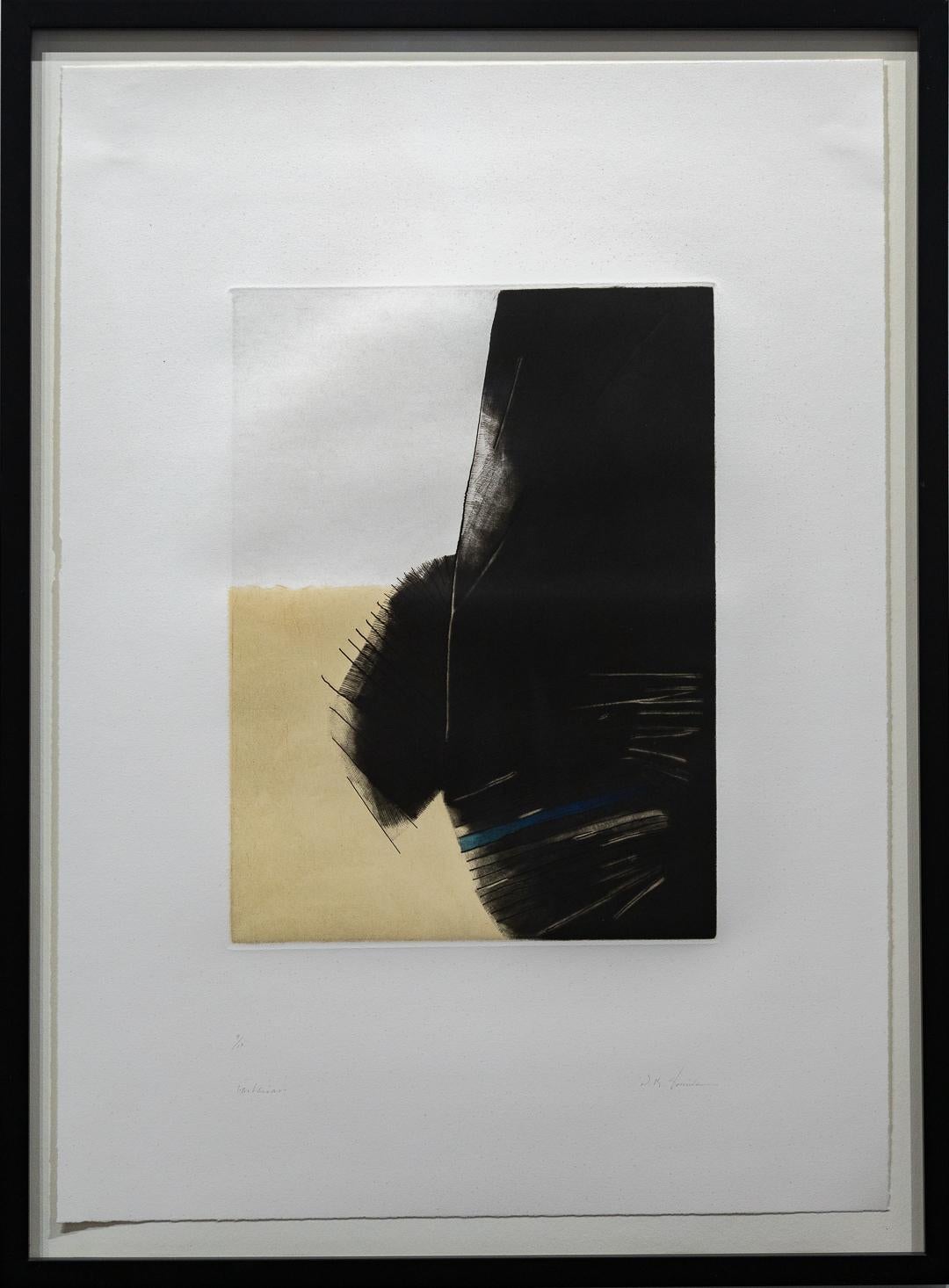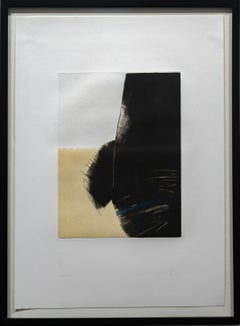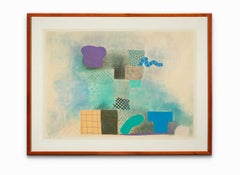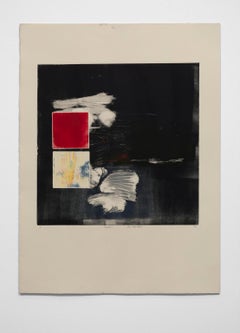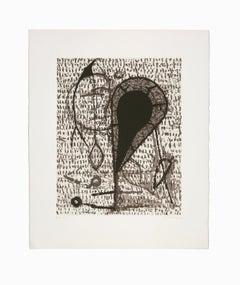Items Similar to Douglas Semivan Abstract Modern "Receiver I" Signed and Numbered
Want more images or videos?
Request additional images or videos from the seller
1 of 8
Douglas SemivanDouglas Semivan Abstract Modern "Receiver I" Signed and Numbered1980 - 1990s
1980 - 1990s
$2,600
£1,981.62
€2,265.12
CA$3,658.04
A$4,007.26
CHF 2,109.27
MX$47,827.76
NOK 26,887.83
SEK 24,579.53
DKK 16,920.03
About the Item
"Receiver I" is an abstract print of three diagonally placed lines. It is reminiscent of an early work by Georgia O'Keeffe, "Blue Lines X" in that both artists, Semivan and O'Keeffe, have achieved a beauty in the placement, width of, length and juxtapositions of simple lines to achieve a never ending balance and harmony for the viewer.
Born in Detroit, Michigan, Douglas Semivan is an artist and retired education who is Professor Emeritus of the Art Department at Madonna University in Livonia, Michigan.
Semivan’s work resides in the permanent collections of several museums: including the Museum of Modern Art, New York, the Detroit Institute of Arts, The Brooklyn Museum, The Toledo Museum of Art, and the Grand Rapids Art Museum. His works are also part of the collections of several corporations: The Ford Motor Copany, William Beaumont Hospital, City National Bank, IBM Corporation, and The Max Factor headquarters in North Carolina.
Semivan was visiting artist at the University of Wisconsin in Madison, WI, Western Michigan University in Kalamazoo, Michigan, Cornish College of the Arts in Seattle, Washington, and Olivet College in Olivet, Michigan.
He received his MFA in Printmaking from The Cranbrook Academy of Art in 1973, and a BA in Art from Olivet College in Olivet, Michigan in 1971. He has taught Lithography at Vancouver School of Art and Wayne State University and was Director of the Detroit Artists Market in Detroit, Michigan.
Semivan's alma mater, The Cranbrook Academy of Art in Bloomfield Hills, Michigan, was designed by architect and faculty member, Eliel Saarinen who collaborated with Charles and Ray Eames on chair and furniture design. Numerous creative artists who are alumni of Cranbrook include: Harry Bertoia, Florence Knoll, Jack Lenor Larsen, Donald Lipski, Duane Hanson, Nick Cave, Hani Rashid, George Nelson, Urban Jupena (Nationally recognized fiber artist), Artis Lane (the first African-American artist to have her sculpture, "Sojourner Truth," commissioned for the Emancipation Hall in the Capital Visitor Center in Washington DC), Cory Puhlman (televised Pastry Chef extraordinaire), Thom O’Connor (Lithographs), Paul Evans (Brutalist-inspired sculpted metal furnishings), Eugene Caples (small bronze images/abstract), Morris Brose (Bronze Sculptures), Herb Babcock (blown glass) and Larry Butcher (mixed media.)
He has a studio and resides in Royal Oak, Michigan. Measurements for print without frame: 19" h x 12.50 " w. This piece is signed and number 7 of 7.
- Creator:Douglas Semivan (1949)
- Creation Year:1980 - 1990s
- Dimensions:Height: 29 in (73.66 cm)Width: 21 in (53.34 cm)
- Medium:
- Movement & Style:
- Period:
- Condition:
- Gallery Location:Detroit, MI
- Reference Number:1stDibs: LU128616084202
About the Seller
5.0
Vetted Professional Seller
Every seller passes strict standards for authenticity and reliability
Established in 2014
1stDibs seller since 2019
110 sales on 1stDibs
Typical response time: 15 hours
- ShippingRetrieving quote...Shipping from: Detroit, MI
- Return Policy
More From This Seller
View AllDouglas Semivan Print "Abstract in Gold and Black"
By Douglas Semivan
Located in Detroit, MI
"Abstract in Gold and Black" is a well-balanced calm piece. The placement of the gold and white can be read as a distant landscape giving much imagined space to the heavier black area which contains a linear element and the color blue. Semivan is a Master Printmaker and sculptor. He often breaks his surfaces and extends beyond the perimeters in his sculptures. The particular placement of the black area in this piece suggests such a breakage beyond the edge where one imagines a continuation of the strokes or linear elements. This is an altogether extraordinary print.
Born in Detroit, Michigan, Douglas Semivan...
Category
Late 20th Century American Modern Abstract Prints
Materials
Paper, Printer's Ink
Robert Natkin Abstract Lithograph Signed Numbered
By Robert Natkin
Located in Detroit, MI
SALE ONE WEEK ONLY
Soft pastel colors in floating smudges lay between and around lyrical abstract geometric and organic forms giving a diaphanous color and shape harmony to the work...
Category
1990s Abstract Expressionist Abstract Prints
Materials
Lithograph
Joyce T. Nagel Monoprint Abstract "Dropout" Signed Dated
Located in Detroit, MI
"Dropout" is one of the monoprints that Joyce Nagel so enjoyed creating. This monoprint is a one-off abstract print. The arrangement of shapes and colors p...
Category
1980s Abstract Expressionist Abstract Prints
Materials
Paper, Ink
"Untitled I", Abstract Etching and Aquatint Lithograph, Signed and Numbered
By Bert Yarborough
Located in Detroit, MI
"Untitled I" is a work that displays Bert Yarborough's experimentation with emotion and monotype in his abstract and expressive style. This print made ...
Category
1990s Abstract Prints
Materials
Etching, Aquatint, Lithograph, Monotype
"Untitled II", Abstract Etching and Aquatint Lithograph, Signed and Numbered
By Bert Yarborough
Located in Detroit, MI
"Untitled II" is a work that displays Bert Yarborough's experimentation with emotion and monotype in his abstract and expressive style. This print made...
Category
1990s Abstract Prints
Materials
Etching, Aquatint, Lithograph, Monotype
Joyce T. Nagel Monoprint "Storm" Signed and Dated
Located in Detroit, MI
"Storm" is one of the monoprints that Joyce Nagel so enjoyed creating. Like an actual storm whose characteristics are unique this monoprint is a one-off pr...
Category
1980s Abstract Expressionist Landscape Prints
Materials
Paper, Ink
You May Also Like
Untitled AP-122 is an expressive mixed-media work on archival cold-press waterco
By Murray Duncan
Located in Toronto, Ontario
Untitled AP-122 is an expressive mixed-media work on archival cold-press watercolor paper, measuring 18 × 24 inches. In this composition, Toronto artist Murray Duncan builds a dynami...
Category
21st Century and Contemporary Abstract Geometric Abstract Paintings
Materials
Paint, Ink, Archival Paper, Pencil
Untitled 3, Minimalist Abstract Lithograph by K.R.H. Sonderborg
By K.R.H. Sonderborg
Located in Long Island City, NY
Artist: K.R.H. Sonderborg, Danish (1923-2008)
Title: Untitled 3
Year: 1969
Medium: Lithograph, signed and numbered in pencil
Edition: 32/100
Size: 39.5 in. x 24.5 in. (100.33 cm x 62...
Category
1960s Abstract Expressionist Abstract Prints
Materials
Lithograph
Untitled AP-121 — Mixed Media Work on Paper by Murray Duncan
Located in Toronto, Ontario
Untitled AP-121 is an expressive mixed-media work on archival cold-press watercolor paper, measuring 18 × 24 inches. In this composition, Toronto artist Murray Duncan builds a dynami...
Category
21st Century and Contemporary Abstract Geometric Abstract Paintings
Materials
Paint, Paper, Ink, Pencil
Genesis 6th Day
By Dennis Ray Beall
Located in San Francisco, CA
This artwork titled "Genesis 6th Day" 1962 is a n original etching, with embossing by noted American artist Dennis Ray Beall, b.1929. It is hand signed, titled, dated and numbered 24...
Category
Mid-20th Century American Modern Abstract Prints
Materials
Etching
Genesis 3th Day
By Dennis Ray Beall
Located in San Francisco, CA
This artwork titled "Genesis 3th Day" 1962 is a n original colors etching , with embossing by noted American artist Dennis Ray Beall, b.1929. It is hand signed, titled, dated and num...
Category
Mid-20th Century American Modern Abstract Prints
Materials
Etching
Untitled #533 by Murray Duncan – Original Contemporary Mixed Media on Paper
Located in Toronto, Ontario
Untitled #533 by Murray Duncan – Contemporary Mixed Media on Paper
Size: 32" x 40"
Unframed, signed on the back
A striking exploration of form and movement, Untitled #527 by Murray ...
Category
21st Century and Contemporary Abstract Geometric Abstract Paintings
Materials
Oil Crayon, Acrylic, Pencil
